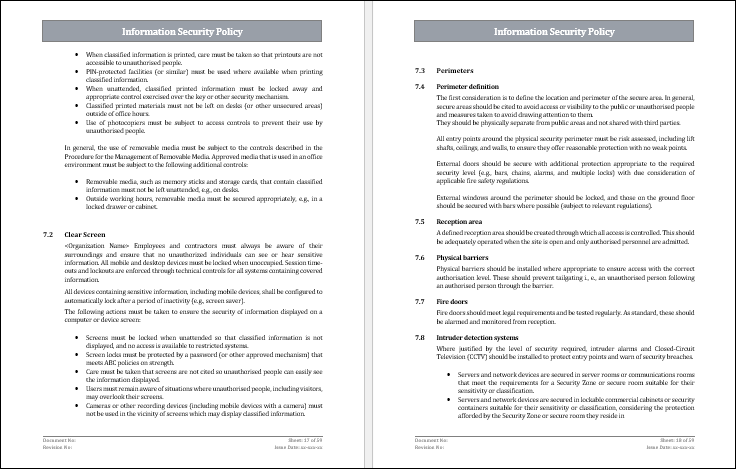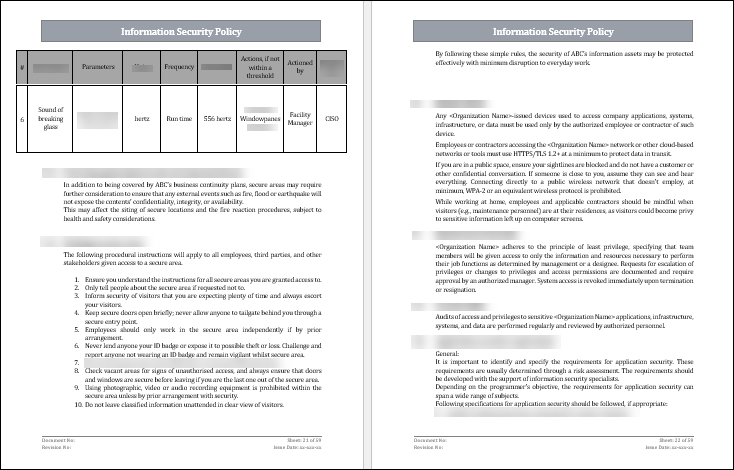What is Information Security Policy? ISMS Policy Word Template

Follow these four steps to reduce the risk of an incident:
1) Establishing an overall approach to security.
2) Documenting security measures.
3) Detecting compromised information assets and minimizing their impact.
4) Protecting your reputation by adhering to legal requirements such as NIST GDPR HIPAA, FERPA, and others.\
Why Does an Information Security Policy Matter?
A good Information Security Policy will help ensure that the right people can access your data. You could suffer significant losses if you do not have a policy to protect your data from hackers or other attacks. A cyber-attack can cost anywhere between $500 billion and $1 trillion, depending on its severity. This is why it's important to create a policy that protects your data.
Five essential tips to help you develop your ISMS Information Security Policy
1) Determine who should be involved with creating an Information Security Policy Template.
2) What kind of data should be protected?
3) Create policies for network usage
4) Define acceptable use guidelines
5) Lastly, describe how violations are reported.
8 Elements of an ISMS Information Security Policy Template:
1. PurposeInformation Security Policy Word Template is essential for any organization. This document should contain the following:
- Information security policies are designed to protect your company by detecting and preventing breaches from third-party vendors, data misuse, applications, computers, mobile devices, networks, or computer systems.
- With an IT Policy, you can meet all ethical, legal, and regulatory requirements.
- Respect customers' privacy by responding to their requests for help when they experience a problem with their privacy or a violation of data protection laws.
- The organization must meet the security requirements for its IT systems.
- Your ISMS Information Security Policy is subject to all applicable laws and regulations, as well as any fines or penalties for non-compliance.
2. Audience
ISMS Policies for information security are an important step in managing data within your organization. To make this document effective, you must know to whom the policy is applicable and to whom it is not. Third-party vendors, for example, can be included in the information security policy you create if that is what you desire. You may not think they need protection because they don't have any legal or regulatory obligations. This is a false assumption, as customers will still hold you responsible for any breach that occurs outside of your control.
3. Data Security Objectives
Information security is a complex and broad field encompassing the CIA triad of confidentiality, integrity, and accessibility. Knowledge security is based on these three goals, and any breach of one will lead to another. Knowledge should remain confidential to prevent unauthorized access and manipulation. If knowledge is lost, corrupted, or compromised, its integrity may also be compromised.
4. Policy on Authority and Access Management
Access Management policies are a set of rules that define the authority of each employee in your company over IT and knowledge systems. The policy should determine how sensitive data is handled; the World Health Organization knows what kind of permissions are required and what approvals are needed before decisions can be made. This document may also include policies regarding knowledge retention periods or other provisions about using knowledge longer.
Once you have decided that the World Health Organization is the rightful authority to make these decisions, it's time to decide who has access to what types of data.
5. Knowledge Classification
The classification of data is an important aspect of knowledge security. This helps protect your company's information by determining how sensitive different data types are. The information can be classified into five categories that indicate the degree of protection required.
- First, you need to be familiar with the rules and regulations that apply in your country or region.
- Second, you can create a map to show the progression of knowledge in your organization.
- Third, you can create a list of all the different types of classified information that could be shared amongst your organization's databases, systems, and networks.
- Fourth, you should review existing documents on security policies and procedures, similar to training materials, to identify any sensitive information that may exist within your company's networks, systems, databases, and repositories.
- Last but not least, you should review the location of your information storage resources in relation to your company's databases, systems, networks, and repositories.
6. Knowledge Support and Operation
Businesses are increasingly concerned about data protection as they store more and more client information. You must first understand what information you possess and how it can be used.
We will define a few steps that will help you to ensure your knowledge is safe:
1) Verify if there are any business standards or restrictive needs in the area that require certain levels of security.
2) Identify the type of sensitive information you want to protect, such as MasterCard numbers.
3) Create policies to handle user requests based on his/her own knowledge.
4) Outline plans of backup services.
5) Implement a method to ensure only licensed personnel can access knowledge.
7. Security Awareness Training
Information security requires a high level of security awareness. Many employees only think about information security when it comes to their jobs. It doesn't matter if you are a CEO or a janitor. Your role in maintaining the integrity and safety of sensitive data is vital. This means knowing how to defend against attacks and other malicious activities such as social engineering.

8. Responsibilities of Employees and their Duties
To operationalize an ISMS policy, employees must understand their responsibilities. This section should be clearly defined for all parties involved, including HR and IT. This section includes the following areas:
- Security programs: Who is responsible? What should these policies include? Acceptable Use Policies - Do you have policies that govern what employees can and cannot do with their computers at work?
- Network security: You must train your staff on how to maintain and protect your network.
- Physical Security: When protecting data, it is important to ensure that companies have the right physical security measures.
- Business continuity: With a well-designed business continuity plan, you can reduce the risk for your company and data.
- Access management: This section of the policy should include Who can access what, how and when they gain access, as well as who has that access.
- Security Awareness: Your employees should be aware of the importance of their roles and responsibilities to your company.
- Risk assessments: A risk analysis will help you to identify your most vulnerable points so that you can take better measures through risk assessment.
- Incident response/incident management: Daily incidents occur, some of which are more serious than others. However, they all require accurate and detailed handling so that the right action can be taken as soon as possible!
Conclusion
An Information Security Policy is the bedrock upon which an organization's commitment to protecting its valuable information assets rests. It is a strategic framework that sets the tone for how data is handled, accessed, and protected within an organization. The importance of such a policy cannot be overstated in today's digital age, where data breaches and cyber threats are ever-present.


